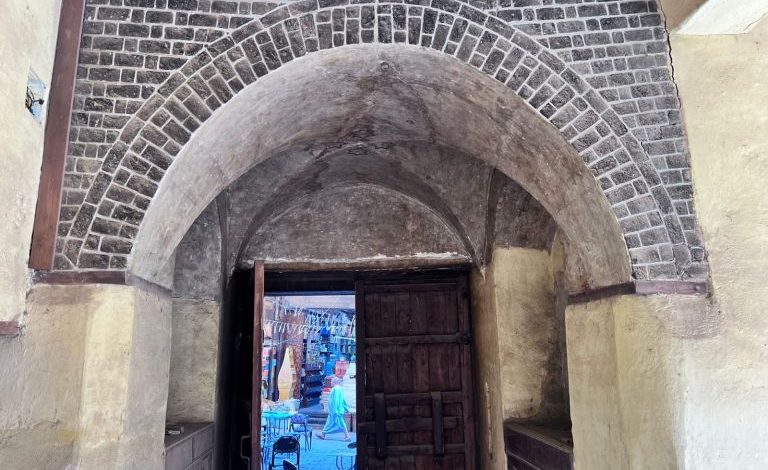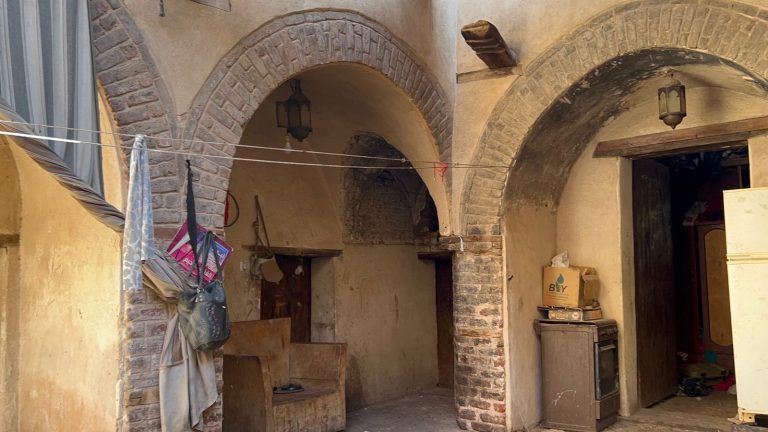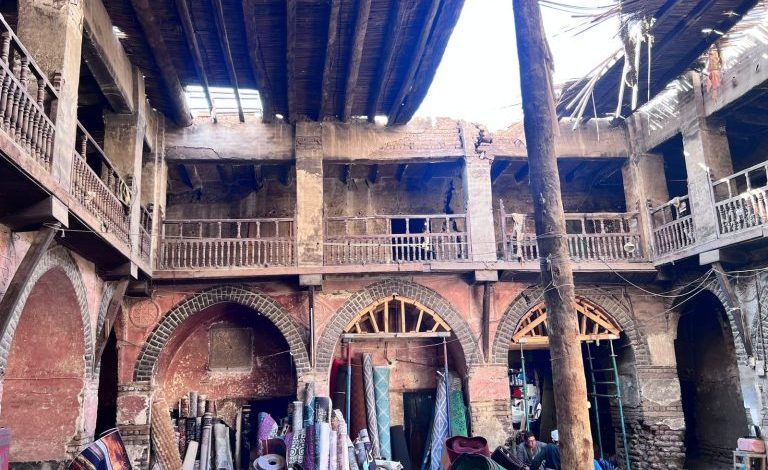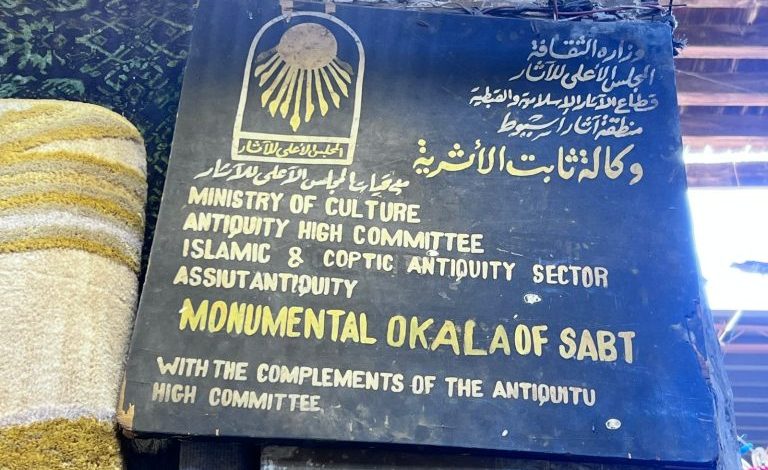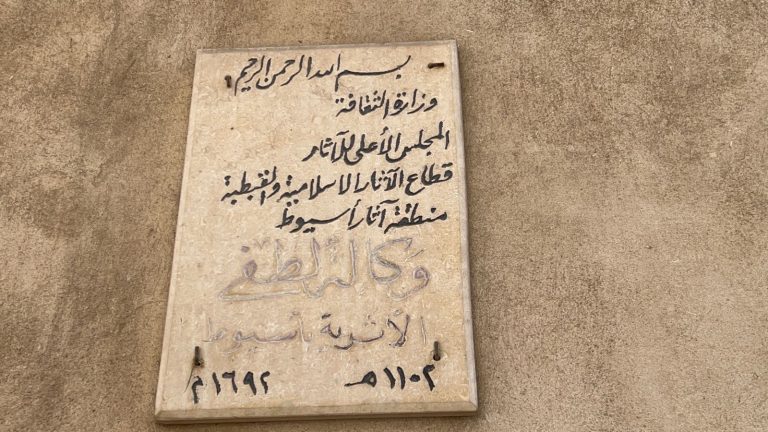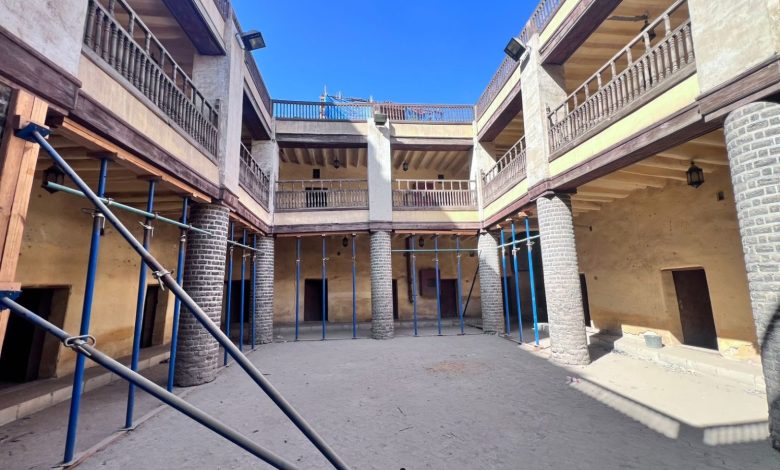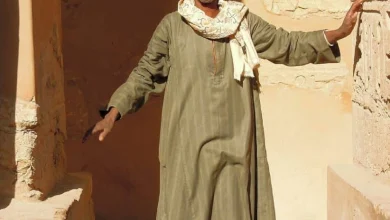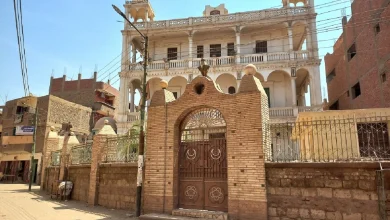“Lutfi,” “Shalabi,” and “Thabet” agencies in Assiut
Since the Ottoman era, Assiut has been an important commercial hub in Upper Egypt, with caravans passing through on their way to Sudan via the Darb al-Arba’in route, and a destination for merchants from around the world. The city has retained its commercial status over time, with the agencies of Lutfi, Shalabi, and Thabit standing in the narrow alleys of Al-Qaisariya as living witnesses to a history spanning more than three centuries. With their Islamic architecture and antique decorative features, these agencies tell the story of a city that was once a thriving center of trade and urban development in Upper Egypt. Today, however, they suffer from neglect and await someone to save them before they are erased from the city’s memory forever.
Assiut’s commercial status
Regarding Assiut’s commercial status, Ali Ahmed Mahfouz, director of antiquities in western Assiut, explains to Bab Masr: “During the Islamic era, the city of Assiut was at the forefront of commercial cities due to its privileged location on the western side of the Nile. It is also centrally located among Egyptian cities.”
Mahfouz adds that Assiut was primarily an agricultural city, with trade coming in second place. However, it flourished commercially during the Mamluk and Ottoman periods, thanks to its easy accessibility via the Nile River or ancient roads such as the Darb al-Arba’in and the Oasis Road. This made it a widely renowned commercial city.
The difference between qaisariyyah and commercial agencies
Mahfouz continues, “Assiut used to have four ‘qaisariyas,’ a Persian word meaning a covered commercial market or shopping mall. Their presence was a reason why Assiut stood out from other commercial cities.”
The four qaisariyas included 34 commercial agencies. Regarding the difference between a qaisariya and an agency, Mahfouz explains: “A qaysariya is a covered market that houses a group of shops specializing in the sale of a single type of commercial goods, such as meat, gold, or fabrics. An agency, on the other hand, is a large commercial center for displaying goods. It also includes accommodation for merchants visiting the city, combining trade, storage, and lodging.”
The Shalabi Agency
The Shalabi Agency, or “Bint Shalabi Agency,” is known as one of the oldest commercial agencies in Asyut. It was founded in 1824 and is registered as an Islamic and Coptic monument. It is attributed to Prince Muhammad al-Kashif bin Zadeh, the governor of Asyut and discoverer of the oases.
The agency consists of four main elements:
- Shops: Located at the front of the agency, their function is to sell, buy, and exchange goods.
- Warehouses: There are 19 warehouses. These are rooms with palm leaf roofs covered with semicircular domes used to store goods. They are preceded by a shed built on ten hollow brick columns.
- The courtyard: This is the inner courtyard that was reserved for animals such as camels, horses, and donkeys belonging to merchants.
- The second floor: This was reserved for accommodating visiting merchants. It is accessed via a staircase on the front side and comprises 19 rooms.
The henna and ostrich feather trade
The Shalabi Agency continued to operate until the 1980s. It welcomed Sudanese merchants who were involved in the henna trade. It was also known for selling products such as ostrich feathers, elephant tusks, and Assiut silk. However, its buildings suffered cracks in the early 1980s, leading to their closure, and they were recently reinforced with metal supports to protect them from collapse. Today, the agency is waiting for someone to come to its rescue so that three centuries of history do not collapse.
Lutfi Agency and Leather Trade
The Lutfi Agency was established in 1692, according to the inscription on its facade. It is currently affiliated with the Supreme Council of Antiquities, Islamic and Coptic Antiquities Sector in Assiut. Mahfouz says: “It was founded by Hajj Lutfi Abdel-Gawad bin Abdel-Bar al-Assiouti, nicknamed the captain of Egypt’s merchants or the captain of its notables, who was a merchant of great standing. His agency specialized in the leather trade. It collected leather from the governorates of Upper Egypt and then transported it to the tanneries. Then to the wall of the eye canal in Cairo.”
The agency has two entrances: the old entrance is a huge monument topped by a triple arch decorated with carved brick and wood, and the second entrance is for animals. The agency includes a group of warehouses for storing goods, topped by a dome, with a single staircase leading to the merchants’ rooms. It was built of mud bricks, palm trunks, and clay to reduce heat. It was one of the first warehouses in Upper Egypt.
Today, it has lost its commercial luster and has become a shelter for some families, awaiting a restoration project that will restore it to its former glory.
Thabit Agency and Water Well
The Thabit Agency is the largest Islamic agency registered among the Islamic and Coptic monuments in Asyut. It was established by Muhammad Thabit, grandson of Prince Muhammad al-Kashif (ruler of Asyut and Kashif al-Wahat) in the 18th century. The agency is distinguished by the presence of an ancient freshwater well in its courtyard, which makes it unique among the agencies of Asyut. It also includes square-shaped storage rooms and a huge monumental entrance overlooking Muhammad Mahmoud Pasha Street (currently Al-Qaisariya), and its original door remains in its original condition.
Like others, the agency welcomed merchants for a nominal fee, with the first floor designated for displaying and storing goods. The second floor was reserved for accommodating visiting merchants when it was time to complete their journeys. These rooms are accessed by a staircase located in the southern corner of the agency. The roof is open and overlooks the courtyard via a wooden balcony. This courtyard is distinguished from other agency courtyards by its gabled roof with a vent that allows air to pass through and cool the interior.
Today, the agency suffers from neglect, with cracked and dirty walls. It has been turned into a warehouse for merchants on Al-Qaisariya Street. Like other agencies, it is also waiting for a helping hand.
Al-Qaisariya Street: Memories and Old Professions
Ahmed Jaber, one of the oldest merchants located next to the Shalabi Agency, says:
“The Qaisariya area is still thriving with various trades. It is home to many ancient traditional crafts. Here you will find coppersmiths and blacksmiths using their traditional tools, as well as major grain merchants. There are also craftsmen whose trades are threatened with extinction, such as municipal upholsterers and handmade shoe makers. This ancient district bears witness to the commercial greatness of Assiut, both past and present.”
Ahmed Mustafa, 75, the oldest coppersmith in the district, who has been working in the profession for 60 years next to these agencies, adds: “Those old heritage agencies created unforgettable memories for everyone. They were operating until the 1980s, and merchants flocked to them from all over the governorates to trade in various products.”
He continued: “I used to make household utensils from copper, which is now rare, and then from aluminum. I also made tools used for measuring grains. The Qaisariya area, with its agencies, was an important commercial center that attracted merchants heading to Sudan, where they brought their goods.”
Neglect of agencies
Mahmoud Muhammad, 68, a local upholsterer who works next to the Lutfi agency, says: “The Lutfi agency was one of the oldest commercial agencies in the Upper Egypt governorates. It was the main source of the leather trade and a source of livelihood for many workers in this profession. Now, however, it no longer plays the role it once did.”
He concluded by saying: “The Lutfi Agency is inhabited by some families, and the Thabit Agency has been turned into a warehouse for carpet and furniture dealers in the Qaisariya markets, even though it is registered with the Ministry of Tourism and Antiquities. These agencies need attention and development so that they do not collapse.”


